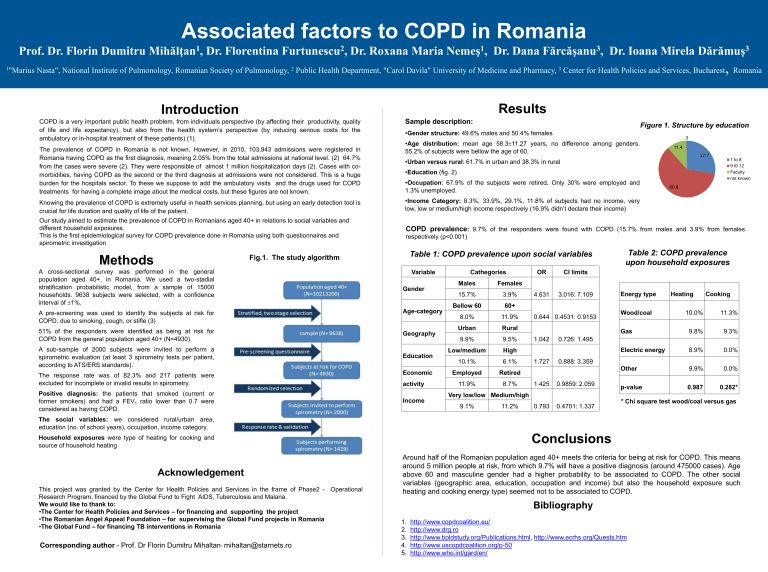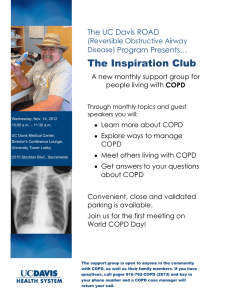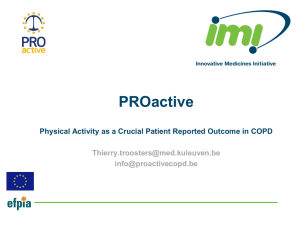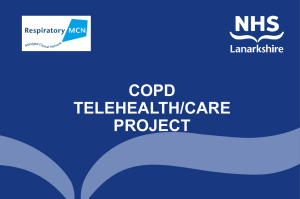
Associated factors to COPD in Romania Prof. Dr. Florin Dumitru 1"Marius 1 Mihălţan , Dr. Florentina 2 Furtunescu , Dr. Roxana Maria 1 Nemeş , Dr. Dana 3 Fărcăşanu , Dr. Ioana Mirela 3 Dărămuş , Romania Nasta", National Institute of Pulmonology, Romanian Society of Pulmonology, 2 Public Health Department, "Carol Davila" University of Medicine and Pharmacy, 3 Center for Health Policies and Services, Bucharest Results Introduction COPD is a very important public health problem, from individuals perspective (by affecting their productivity, quality of life and life expectancy), but also from the health system’s perspective (by inducing serious costs for the ambulatory or in-hospital treatment of these patients) (1). The prevalence of COPD in Romania is not known. However, in 2010, 103,943 admissions were registered in Romania having COPD as the first diagnosis, meaning 2.05% from the total admissions at national level. (2) 64.7% from the cases were severe (2). They were responsible of almost 1 million hospitalization days (2). Cases with comorbidities, having COPD as the second or the third diagnosis at admissions were not considered. This is a huge burden for the hospitals sector. To these we suppose to add the ambulatory visits and the drugs used for COPD treatments for having a complete image about the medical costs, but these figures are not known. Sample description: Figure 1. Structure by education •Gender structure: 49.6% males and 50.4% females •Age distribution: mean age 58.311.27 years, no difference among genders. 55.2% of subjects were bellow the age of 60. ,3 11,4 27,7 1 to 8 9 t0 12 Faculty not known •Urban versus rural: 61.7% in urban and 38.3% in rural •Education (fig. 2) •Occupation: 67.9% of the subjects were retired. Only 30% were employed and 1.3% unemployed. 60,6 Knowing the prevalence of COPD is extremely useful in health services planning, but using an early detection tool is crucial for life duration and quality of life of the patient. •Income Category: 8.3%, 33.9%, 29.1%, 11.8% of subjects had no income, very low, low or medium/high income respectively (16.9% didn’t declare their income) Our study aimed to estimate the prevalence of COPD in Romanians aged 40+ in relations to social variables and different household exposures. This is the first epidemiological survey for COPD prevalence done in Romania using both questionnaires and spirometric investigation COPD prevalence: 9.7% of the responders were found with COPD (15.7% from males and 3.9% from females respectively (p<0.001) Table 1: COPD prevalence upon social variables Fig.1. The study algorithm Methods A cross-sectional survey was performed in the general population aged 40+, in Romania. We used a two-stadial stratification probabilistic model, from a sample of 15000 households. 9638 subjects were selected, with a confidence interval of 1%. A pre-screening was used to identify the subjects at risk for COPD, due to smoking, cough, or stifle (3) 51% of the responders were identified as being at risk for COPD from the general population aged 40+ (N=4930). A sub-sample of 2000 subjects were invited to perform a spirometric evaluation (at least 3 spirometry tests per patient, according to ATS/ERS standards). The response rate was of 82.3% and 217 patients were excluded for incomplete or invalid results in spirometry. Positive diagnosis: the patients that smoked (current or former smokers) and had a FEV1 ratio lower than 0.7 were considered as having COPD. Variable Gender Age-category Geography Education Economic activity Income Cathegories Males Females 15.7% 3.9% Bellow 60 60+ 8.0% 11.9% Urban Rural 9.9% 9.5% Low/medium High 10.1% 6.1% Employed Retired 11.9% 8.7% OR CI limits 4.631 3.016: 7.109 0.644 0.4531: 0.9153 1.042 1.727 1.425 Table 2: COPD prevalence upon household exposures Energy type Wood/coal Heating Cooking 10.0% 11.3% Gas 9.8% 9.3% Electric energy 8.9% 0.0% Other 9.9% 0.0% p-value 0.987 0.282* 0.726: 1.495 0.888: 3.359 0.9859: 2.059 Very low/low Medium/high 9.1% 11.2% 0.793 0.4701: 1.337 * Chi square test wood/coal versus gas The social variables: we considered rural/urban area, education (no. of school years), occupation, income category. Conclusions Household exposures were type of heating for cooking and source of household heating Acknowledgement This project was granted by the Center for Health Policies and Services in the frame of Phase2 - Operational Research Program, financed by the Global Fund to Fight AIDS, Tuberculosis and Malaria. We would like to thank to: •The Center for Health Policies and Services – for financing and supporting the project •The Romanian Angel Appeal Foundation – for supervising the Global Fund projects in Romania •The Global Fund – for financing TB interventions in Romania Corresponding author - Prof. Dr Florin Dumitru Mihaltan, mihaltan@starnets.ro Around half of the Romanian population aged 40+ meets the criteria for being at risk for COPD. This means around 5 million people at risk, from which 9.7% will have a positive diagnosis (around 475000 cases). Age above 60 and masculine gender had a higher probability to be associated to COPD. The other social variables (geographic area, education, occupation and income) but also the household exposure such heating and cooking energy type) seemed not to be associated to COPD. Bibliography 1. 2. 3. 4. 5. http://www.copdcoalition.eu/ http://www.drg.ro http://www.boldstudy.org/Publications.html, http://www.ecrhs.org/Quests.htm http://www.uscopdcoalition.org/p-50 http://www.who.int/gard/en/






